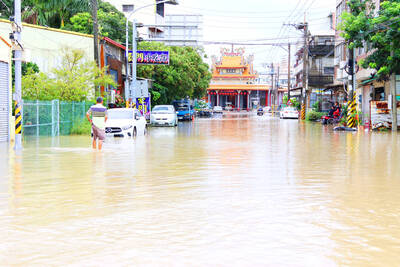The Presidential Office and the Democratic Progressive Party (DPP) will hold a debate on the government’s proposed economic cooperation framework agreement (ECFA) with China in a live TV session on April 25.
The debate, to be hosted by the Taiwan Public Television Service Foundation, will take place at 2pm and will be moderated by Huang Ming-ming (黃明明), one of the channel’s news anchors.
President Ma Ying-jeou (馬英九) and DPP Chairperson Tsai Ing-wen (蔡英文) will each ask and respond to five questions and issue five additional rebuttals, said Presidential Office Spokesperson Lo Chih-chiang (羅智強) and DPP Spokesperson Tsai Chi-chang (蔡其昌) in announcing the format in a joint press conference last night.
The questions are expected to focus on the effects an ECFA would have on jobs, the content of the government’s closed-door negotiations with China and the “early harvest” list of goods and services that will be subject to immediate tariff concessions or exemptions.
The list, which is reported to include 500 items on Taiwan’s side and 700 items on China’s side, is a sore point for the DPP, which argues that it would be unable “to hold a fair debate” unless the government discloses the content ahead of the event.
Lo said he would take the DPP’s requests, which also include disclosing the content of the 20 articles that would reportedly form the full text of the agreement, back to the Presidential Office for further consideration.
In return, the Presidential Office has asked the DPP to make public its alternatives to an ECFA and how it intends to develop further cross-strait economic ties.
Also last night, the Government Information Office (GIO), in conjunction with New York-based Overseas Press Club of America Foundation, held a teleconference for academics in Taiwan and the US to exchange views on an ECFA and Asia-Pacific economic integration.
Panel members participating in New York included American Institute in Taiwan Director Douglas Paal and visiting fellow at the Peterson Institute for International Economics Daniel Rosen.
In Taiwan, former minister of the Council for Economic Planning and Development Chen Tain-Jy (陳添枝) and Philip Hsu (徐斯勤), executive director of National Taiwan University’s Center for China Studies, participated.
Paal, who is also vice president of the Carnegie Endowment for International Peace, said that signing an ECFA would help Taiwan “reverse marginalization” amid regional economic integration.
An ECFA would restructure the region, provide Taiwan with more economic opportunities in the region and open up the possibility for Taiwan to sign free-trade deals with Southeast Asian countries, Paal said.
Rosen rejected the idea that an ECFA would make a US-Taiwan FTA more likely and said he did not consider a US-Taiwan free-trade agreement to be advisable, either for the US or Taiwan. Rosen suggested instead that Taiwan pursue inclusion in the Trans-Pacific Partnership.
GIO Minister Johnny Chiang (江啟臣) denied the event was part of a government campaign to promote an ECFA. The topic was chosen because many overseas journalists have been intrigued by an ECFA, he said.

WAITING GAME: The US has so far only offered a ‘best rate tariff,’ which officials assume is about 15 percent, the same as Japan, a person familiar with the matter said Taiwan and the US have completed “technical consultations” regarding tariffs and a finalized rate is expected to be released soon, Executive Yuan spokeswoman Michelle Lee (李慧芝) told a news conference yesterday, as a 90-day pause on US President Donald Trump’s “reciprocal” tariffs is set to expire today. The two countries have reached a “certain degree of consensus” on issues such as tariffs, nontariff trade barriers, trade facilitation, supply chain resilience and economic security, Lee said. They also discussed opportunities for cooperation, investment and procurement, she said. A joint statement is still being negotiated and would be released once the US government has made

NEW GEAR: On top of the new Tien Kung IV air defense missiles, the military is expected to place orders for a new combat vehicle next year for delivery in 2028 Mass production of Tien Kung IV (Sky Bow IV) missiles is expected to start next year, with plans to order 122 pods, the Ministry of National Defense’s (MND) latest list of regulated military material showed. The document said that the armed forces would obtain 46 pods of the air defense missiles next year and 76 pods the year after that. The Tien Kung IV is designed to intercept cruise missiles and ballistic missiles to an altitude of 70km, compared with the 60km maximum altitude achieved by the Missile Segment Enhancement variant of PAC-3 systems. A defense source said yesterday that the number of

Taiwanese exports to the US are to be subject to a 20 percent tariff starting on Thursday next week, according to an executive order signed by US President Donald Trump yesterday. The 20 percent levy was the same as the tariffs imposed on Vietnam, Sri Lanka and Bangladesh by Trump. It was higher than the tariffs imposed on Japan, South Korea and the EU (15 percent), as well as those on the Philippines (19 percent). A Taiwan official with knowledge of the matter said it is a "phased" tariff rate, and negotiations would continue. "Once negotiations conclude, Taiwan will obtain a better

FLOOD RECOVERY: “Post-Typhoon Danas reconstruction special act” is expected to be approved on Thursday, the premier said, adding the flood control in affected areas would be prioritized About 200cm of rainfall fell in parts of southern Taiwan from Monday last week to 9am yesterday, the Central Weather Administration (CWA) said. Kaohsiung’s Taoyuan District (桃源) saw total rainfall of 2,205mm, while Pingtung County’s Sandimen Township (三地門) had 2,060.5mm and Tainan’s Nanhua District (南化) 1,833mm, according to CWA data. Meanwhile, Alishan (阿里山) in Chiayi County saw 1,688mm of accumulated rain and Yunlin County’s Caoling (草嶺) had 1,025mm. The Pingtung County Government said that 831 local residents have been pre-emptively evacuated from mountainous areas. A total of 576 are staying with relatives in low-lying areas, while the other 255 are in shelters. CWA forecaster